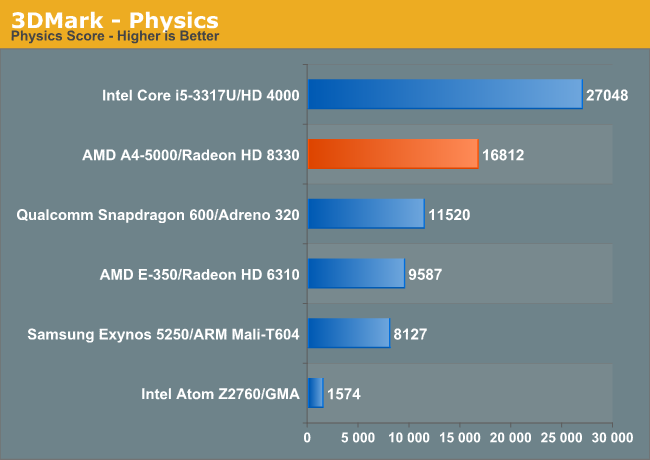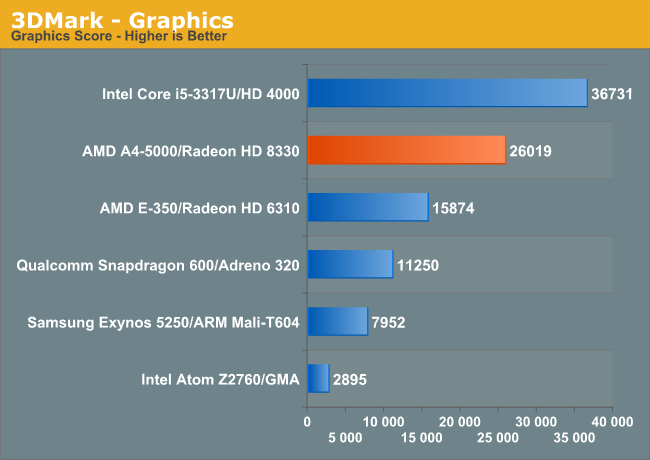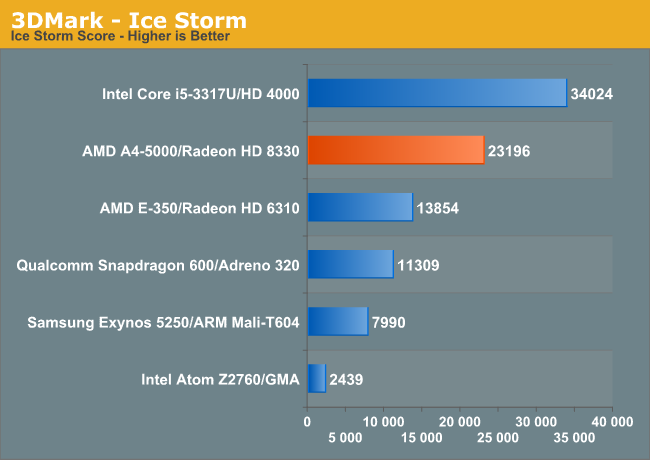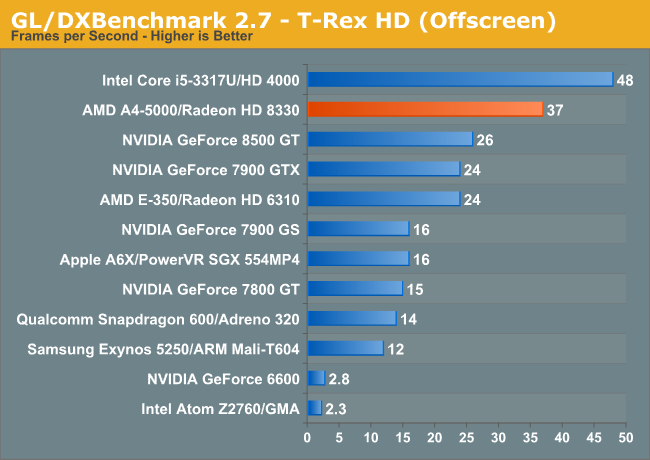The AMD Kabini Review: A4-5000 APU Tested
by Jarred Walton on May 23, 2013 12:00 AM ESTKabini vs CT/ARM: GPU Performance
I pulled out 3DMark and GFXBenchmark (formerly GL/DXBenchmark) for some cross platform GPU comparisons. We'll start with 3DMark Ice Storm and its CPU bound multithreaded physics benchmark:

The physics test is a bit unreasonably multithreaded, which is why we see a 75% uplift compared to AMD's E-350. For FP heavy game physics workloads however, Jaguar does quite well. While a big Ivy Bridge is still going to be quicker, AMD's A4-5000 gets surprisingly close given its much lower cost.
The 3DMark graphics test is more of what we're interested in seeing here. Two GCN compute units (128 SPs/cores) running at 500MHz will really put the old Radeon HD 6310 in Brazos to shame:

The results are quite good. Kabini manages a 61% performance advantage over AMD's old Brazos platform, and actually gets surprisingly close to Intel's HD 4000 in performance. As we discovered earlier, this isn't really enough performance to play modern PC games but casual (and especially tablet) gaming workloads should do wonderfully here.

The overall Ice Storm score just incorporates both physics and graphics test components. As expected, Kabini continues to lead over everything other than the i5-3317U.
Finally we have the GFXBenchmark T-Rex HD test. I threw in a handful of older PC GPUs, although keep in mind that T-Rex HD isn't very memory bandwidth intensive (penalizing some of the old big PC GPUs that had good amounts of memory bandwidth). The test is also better optimized for unified shader architectures, which helps explain the 8500 GT's excellent performance here.

Kabini does very well in this test as well. If we look at the tablet-oriented Temash part (A4-1200) we see that the number of GCN compute units remains unchanged, but max GPU frequency drops to 225MHz from 500MHz. If we assume perfect scaling with GPU clock speed, Temash could offer roughly the same graphics performance as the 4th generation iPad. AMD claims the A4-1200 Temash APU carries a TDP of only 3.9W, a potentially very interesting part from a GPU perspective if our napkin math holds true.
OpenCL Performance
For our last comparison we're looking at the OpenCL performance of these on-die GPUs. We're using a subset of Ryan's GPU Compute workload, partially because many of those tests don't work properly on Kabini yet and also because some of those tests are really built for much more powerful GPUs. We've got LuxMark 2.0 and two CLBenchmark 1.1.3 tests here. Their descriptions follow:
SmallLuxGPU is an OpenCL accelerated ray tracer that is part of the larger LuxRender suite. Ray tracing has become a stronghold for GPUs in recent years as ray tracing maps well to GPU pipelines, allowing artists to render scenes much more quickly than with CPUs alone.
CLBenchmark contains a number of subtests; we’re focusing on the most practical of them, the computer vision test and the fluid simulation test. The former being a useful proxy for computer imaging tasks where systems are required to parse images and identify features (e.g. humans), while fluid simulations are common in professional graphics work and games alike.
| OpenCL GPU Performance | ||||||||||||||||
| LuxMark 2.0 | CLBenchmark—Vision | CLBenchmark—Fluid | ||||||||||||||
| AMD A5-5000 (Radeon HD 8330) | 18K samples/s | 1041 | 1496 | |||||||||||||
| AMD E-350 (Radeon HD 6310) | 23K samples/s | 292 | 505 | |||||||||||||
| Intel Core i5-3317U (HD 4000) | 107K samples/s | 819 | 1383 | |||||||||||||
LuxMark is really a corner case here where Kabini shows a performance regression compared to Brazos. The explanation is simple: some workloads are better suited to AMD's older VLIW GPU architectures. GCN is a scalar architecture that is usually going to net more efficient usage, but every now and then you'll see a slight regression. Intel's HD 4000 actually does amazingly well in the LuxMark 2.0 benchmark.
Our two CLBenchmark tests however paint a very different picture. Here Kabini not only significantly outperforms its predecessor, but is faster than Ivy Bridge as well.










130 Comments
View All Comments
Kevin G - Thursday, May 23, 2013 - link
Those aren't real benchmarks, just estimates that are based upon improvements from an anonymous source.TerdFerguson - Thursday, May 23, 2013 - link
It should be criminal to market any of these chips as "Elite Performance" platforms. The words elite and performance have pretty well understood meanings, which nothing AMD is offering stand up to. If I'm shopping for a new computer and it is advertised as an elite performance platform, I'm going to expect it to run AAA games at elite settings.AMD is distancing themselves from my wallet a little more every day, thanks to weak products, weak initiatives, hype and terribly dishonest marketing.
Finally - Thursday, May 23, 2013 - link
I want a Kabini in my Office PC, I want one in my 13' laptop and I surely will be recommending them to all my friends.lmcd - Thursday, May 23, 2013 - link
Don't know about in your office PC unless you're an Office-only type of worker. I guess that applies to a lot, but I wouldn't know. I could see it in an AIO for office type of deal, or nice, SFF setups. I feel like multi-seat and/or thin-client setups would be cheaper though. May as well buy that i3 if you're getting an independent machine.wumpus - Saturday, May 25, 2013 - link
Considering just how many office machines are running XP (the pentium4s only get replaced when they burn up, the core-based products are likely to stay until the IT department adopts some faddish idiocy*).* not saying that core+windows is irreplaceable, just that stupid business fads are much more likely than real reasons to replace them, the money being available, and enough pointy haired bosses on board at the same time.
kyuu - Thursday, May 23, 2013 - link
Uh huh, I'm sure you were totally predisposed toward getting an AMD product until you saw that marketing-speak.Dude, it's marketing. Intel is just as (if not more guilty) of the same. Feel free to hate marketing-speak -- I certainly do. But let's not pretend it's something unique to AMD, m'kay?
And uh, there's nothing weak about Jaguar, from what I can see. It looks like the best low-power x86 SoC bar by a large measure.
kyuu - Thursday, May 23, 2013 - link
It looks like the best low-power x86 SoC by a large measure.**yannigr - Thursday, May 23, 2013 - link
You are free to buy an Intel product, you know Intel, that beautiful company that in the past was threatening anyone thinking that he could sell PC's with Athlon's. That behavior off course has nothing to do with words like "criminal" or "dishonest marketing". So go and buy an Intel system, the "dishonest marketing" free and "criminal" hardware.yannigr - Thursday, May 23, 2013 - link
I meant "criminal" free hardware off course.Intel, because we hate monopoly.
lmcd - Thursday, May 23, 2013 - link
Ya know, it happened, but an i3 ULV with 4k graphics knocks this chip silly, to ignore GT3e coming around the corner. Sorry but it's to the point where Intel will never need such moves again.